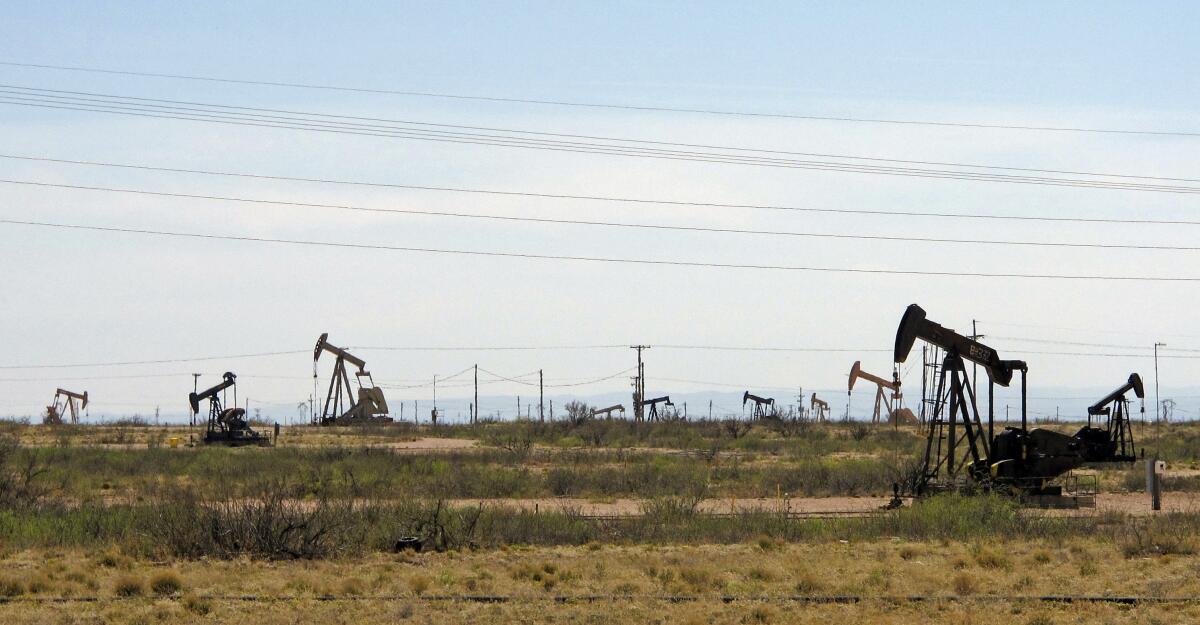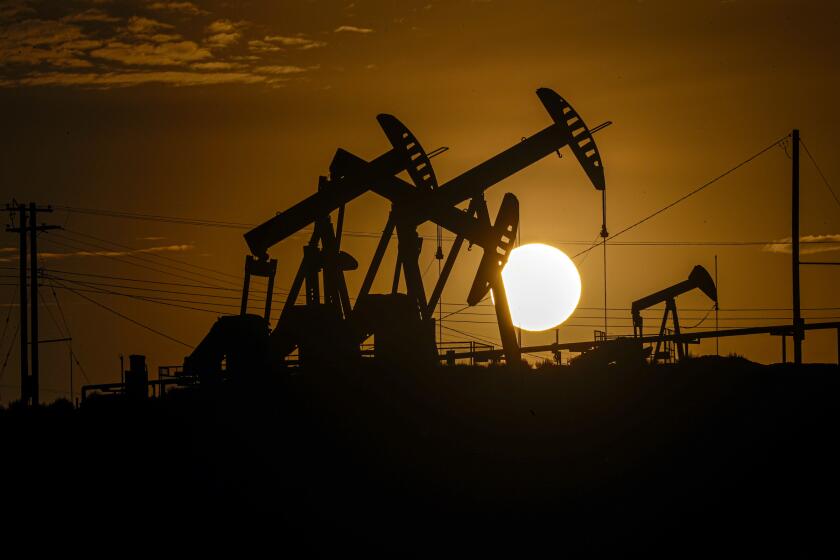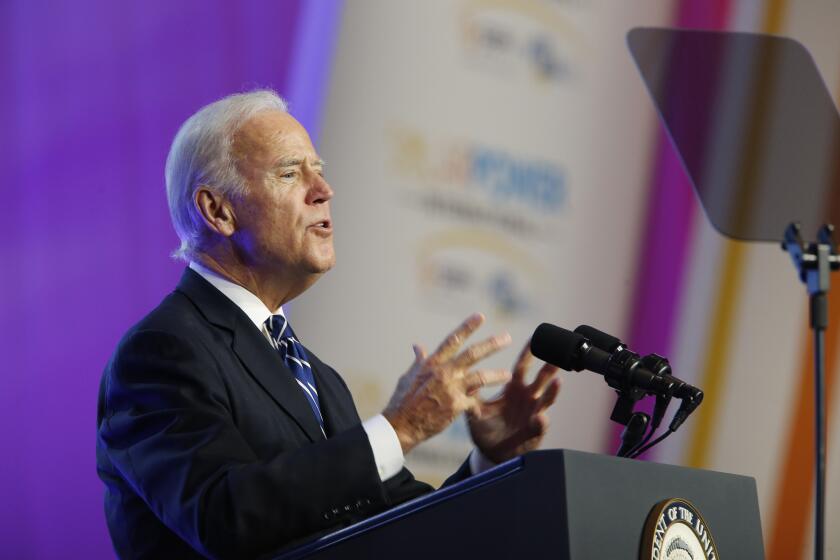Oil companies lock in drilling, challenging Biden on climate change

- Share via
BILLINGS, Mont. — In the closing months of the Trump administration, energy companies stockpiled enough drilling permits for western public lands to keep pumping oil for years and undercut President-elect Joe Biden’s plans to curb new drilling because of climate change, according to public records and industry analysts.
An Associated Press analysis of government data shows the permit stockpiling has centered on oil-rich federal lands in New Mexico and Wyoming. It accelerated during the fall as Biden was cementing his lead over President Trump and peaked in December, aided by speedier permitting approvals since Trump took office.
The goal for companies is to lock in drilling rights on oil and gas leases on vast public lands where they make royalty payments on any resources extracted. Biden wants to end new drilling on those same lands as part of his overhaul of how Americans get energy, with the goal of making the nation carbon neutral by 2050.
Companies submitted more than 3,000 drilling permit applications in a three-month period that included the election, according to data from the U.S. Bureau of Land Management. Officials approved almost 1,400 drilling applications during that time amid the pandemic. That’s the highest number of approvals during Trump’s four-year term, according to AP’s analysis.
In Colorado, a dozen permits are approved or pending to drill in Pawnee National Grassland, a birding destination where wildflowers and cactuses bloom below the buttes.
In Wyoming’s Thunder Basin National Grassland, a prairie expanse that abounds with wildlife and offers hiking, fishing and hunting, oil companies EOG Resources and Devon Energy — which amassed the most federal permits this year — have permission to drill three dozen wells among fields of sage brush.
The administration issued more than 4,700 drilling permits in 2020 — comparable to approval numbers from early last decade when oil topped $100 a barrel, roughly twice the current price.
Invitation to drill
Making it easier to drill was a centerpiece of Trump’s effort to boost American energy production in part by enticing companies onto lands and offshore areas run by the U.S. departments of Interior and Agriculture.
Under Trump, crude production from federal and tribal lands and waters increased sharply, topping a billion barrels in 2019. That was up by almost a third from the last year of the Obama administration.
But this year the coronavirus pandemic and crashing oil prices caused many companies to curtail their activity.
The Bureau of Land Management is continuing with plans to sell oil leases in California despite opposition from the incoming Biden administration.
With markets still in flux and oil producers slashing budgets, major companies nevertheless have been acquiring enough permits to keep pumping through Biden’s upcoming term. The government approved about 500 new drilling permits in September, more than double the same month in 2019.
The oil industry’s fear is that Biden will follow through on campaign pledges and make it impossible or much harder to drill on public lands. “You go from having a champion in the White House, who steers the entire federal apparatus to wanting you to be successful, to someone who is hostile to the industry,” said Tom Pyle, a former Republican aide on Capitol Hill who now leads the industry group American Energy Alliance.
For Biden supporters, the stockpiling threatens parts of an ambitious climate agenda before the Democrat can get into the White House. Oil and gas extracted from public lands and waters generates the equivalent of almost 550 million tons of greenhouse gases annually, the U.S. Geological Survey said in a 2018 study.
Trump administration critics say officials enabled the industry to reach its goals, noting that Interior Secretary David Bernhardt and others have boasted how speedily permits were processed.
The Trump administration moves toward a lease sale in the Arctic National Wildlife Refuge for oil and gas drilling, despite environmental concerns.
Bureau of Land Management spokesman Chris Tollefson said the agency had streamlined permitting while still following environmental laws.
“Markets, not the BLM, determine how oil and gas developers decide to acquire and develop leases,” he said.
Processing times for completed applications to the BLM have dropped from almost 140 days on average in the last year of Obama’s administration to 44 days in fiscal year 2019, according to congressional testimony by Interior officials. In 2020, some companies had permits awarded in a little over a month, AP found. Other permits took longer, but an average could not be determined.
Years’ worth of permits
To undo the late-term awarding of so many permits, a former senior Interior Department official said the Biden administration could be forced to pay millions of dollars to companies to get them to relinquish drilling rights. Such a scenario played out in pristine areas of Montana where officials spent decades trying to buy out companies with drilling leases near Glacier National Park.
“This is classic, end of administration stuff, but for the Trump administration it’s on steroids,” said Jim Lyons, deputy assistant secretary of Interior under Obama.
Houston-based EOG Resources amassed the most permits this year — 1,024 — including 549 since September, according to AP’s analysis.
In total, EOG has about 2,500 federal permits approved or in progress. “If he [Biden] tries to impose some regulations on how new federal permits are issued, we certainly already have an inventory, a large inventory, of existing federal permits that will sustain activity for several years,” company CEO Lloyd Helms told a November investors conference.
Oklahoma-based Devon Energy collected the second-highest number this year. As the presidential campaign wore on this summer, Devon executives assured investors that the company was amassing permits. By October, Vice President David Harris said the company had enough “federal drilling permits in hand that essentially cover all of our desired activity over the next presidential term.”
Devon’s more than 500 permits secured this year resulted from a long-term business strategy, not a political calculation, said spokeswoman Lisa Adams. “It was something in the works for years,” Adams said.
Potential moratorium
Biden is nominating New Mexico Rep. Deb Haaland as interior secretary. And Haaland, who co-sponsored the Green New Deal by liberal Democrats, has said she opposes fracking and drilling on public land.
Even if Biden doesn’t immediately ban new permits, he could place a moratorium on them to study the situation in more detail, said Leo Mariani, managing director of equity research at KeyBank Capital Markets.
Joe Biden wants to reach 100% clean energy by 2035. But activists are worried he’ll choose Ernest Moniz for Energy secretary.
Most companies have up to two years to act on federal permits, so a one-year moratorium wouldn’t have much impact on oil supply, and they could shift production to private or state-owned land, Mariani said.
But such a shift would come at a cost, because royalty rates on private or state-owned land can be twice as much as federal land.
“Because the break-evens are so much lower, you’re not going to see every dollar re-allocated to other places,” said Parker Fawcett, analyst for S&P Global Platts Analytics.
With a ban on new federal drilling permits, U.S. production could fall by about 1 million barrels per day, or about 10%, by 2024, Fawcett estimates. “You will have a supply impact.”
Producers started talking about mitigating their risks about a year ago after Democratic presidential candidate and Sen. Elizabeth Warren said she would ban fracking on federal lands, said Artem Abramov, partner and head of shale research at Rystad Energy.
Then companies began amassing federal drilling permits at more than $10,000 apiece.
More than 60% of the permit applications filed over the past year were in New Mexico, where about a quarter of the state budget comes from oil and gas revenues. And 20% of the permit applications were filed in Wyoming, where Gov. Mark Gordon says the state budget has taken a one-third revenue hit mainly because of the oil downturn.
“I definitely wouldn’t expect the New Mexican state government to support radical moves,” Abramov said. “They would push Biden toward a more gradual approach” to the oil and gas industry.
More to Read
Sign up for Essential California
The most important California stories and recommendations in your inbox every morning.
You may occasionally receive promotional content from the Los Angeles Times.













